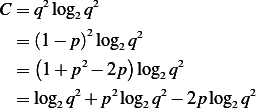 with probability
with probability  and
and  .
Now consider a sequence of 2 outputs as a single symbol
.
Now consider a sequence of 2 outputs as a single symbol  ,
Assuming that consecutive outputs from the source are statically independent, show directly that
,
Assuming that consecutive outputs from the source are statically independent, show directly that

Consider a source which generates 2 symbols  with probability
with probability  and
and  .
Now consider a sequence of 2 outputs as a single symbol
.
Now consider a sequence of 2 outputs as a single symbol  ,
Assuming that consecutive outputs from the source are statically independent, show directly that
,
Assuming that consecutive outputs from the source are statically independent, show directly that

Solution
First find 

Where  in this case is 2. The above becomes
in this case is 2. The above becomes

Hence  becomes
becomes
Now, we conside  Below we write
Below we write  with the probability of each 2 outputs as single symbol on top
of each. Notice that since symbols are statistically independent, then
with the probability of each 2 outputs as single symbol on top
of each. Notice that since symbols are statistically independent, then  , we
obtain
, we
obtain

Hence since

Where  now, the above becomes
now, the above becomes
Now we will expand the terms labeled above as  and simplify, then we will obtain (1) showing the
desired results.
and simplify, then we will obtain (1) showing the
desired results.



Substitute the result we found for  back into (2) we obtain
back into (2) we obtain

But the above can be written as
Compare (4) and (1), we see they are the same.
Hence

A source emits sequence of independent symbols from alphabet  of symbols
of symbols  with probabilities
with probabilities
 , find the entropy of the source alphabet
, find the entropy of the source alphabet
Solution

Where  , hence the above becomes
, hence the above becomes

But  , hence the above becomes
, hence the above becomes

To verify, we know that  must be less than or equal to
must be less than or equal to  where
where  in this case,
hence
in this case,
hence  or
or  , therefore, our result above agrees with this upper limit
restriction.
, therefore, our result above agrees with this upper limit
restriction.